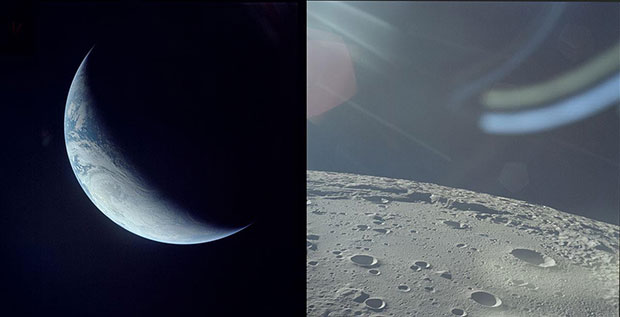From the Moon to the Earth: Changing Perspectives

On July 20, 1969, Commander Neil Armstrong descended from the lunar module to become the first human to ever step on the surface of the Moon: "That's one small step for man, one giant leap for mankind," he famously said.
More than 50 years later, the next Moon landings are being prepared with the goal of landing the first woman on the Moon by 2024.
This shows that we are still eager to explore the unknown and grasp the mysteries of the vast, wonderful universe. However, space exploration also puts the value of planet Earth -- our only home -- in perspective, encouraging us to appreciate its beauty and importance.
 |
| Crescent Earth by Apollo 4, November 1967 and Moon Surface by Apollo 12, November 1969. Credit: NASA JPL |
An Awe-Inspiring Achievement
In September 1962, John F. Kennedy delivered a breakthrough speech in which he defined space as the "new frontier," and successfully invoked the pioneer spirit in the name of humanity and peace. His "We choose to go to the Moon" speech inspired many. However, the pessimists were shaking their heads, claiming it would be a nearly impossible task.
After all, we didn't have the tools to undertake such a task back then. Yet in the following years, NASA and its 400,000 employees worked tirelessly to introduce inventions like spacesuits and landing modules from scratch. Actually, the Apollo flight computer design was the driving force behind early research into microchips, leading to the development of computers and sparking the digital revolution in which we live today.
Despite the technical limitations of the era, some 600 million people (an estimated one fifth of the world population back then) watched the historic broadcast of the first Moon landing seven years after Kennedy's promise, proving to humanity the incredible goals achievable by collective collaboration.

Kickstarting Environmentalism
Although some may think the main outcomes of space exploration are the inventions of Velcro and non-sticking pans, or the dreams of holidaying on Mars one day, it has by far more important effects.
First, it allows us to observe and understand both our origins and the principles of physics, energy, matter and time itself. Second, it advances the development of technologies and strategies that can help humanity thrive.
It also has a third consequence that was not foreseen by scientists and engineers: It widens our cosmic perspective, confronting us with the vastness of the universe. It offers a unique point of view to reflect on our home, and on humanity and its endeavors -- a point of view that significantly defined the environmentalist movement.
It's no coincidence that Earth Day (April 22) was established only 15 months after the publication of "Earthrise." The pacifist and activist John McConnell made flags with the iconic photograph and gave them to the people at the Moon watch of the Apollo 11 landing in 1969. He then had the idea of celebrating Earth Day, the first environmental festival. One year later, Earth Day was officially accepted and has been on our calendars since.
These new views of the Earth from space were an unforeseen revelation. The first missions to other worlds inspired interest in ecology and the protection of the Earth's environment. At the same time, scientific advances led to a greater understanding of the human impact on the planet.
For the first time, many realized that we had the potential to disrupt or even destroy Earth's life-support systems. The sense of environmental crisis was intensified by social and political turmoil, something we are seeing again today.




0 Comments